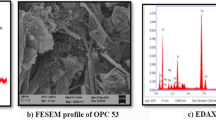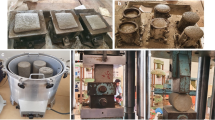Abstract
Aerated concrete is a type of lightweight concrete in which air bubbles are incorporated into concrete using aluminium powder to make it light in weight. The manufacture of aerated concrete blocks without affecting the quality using waste rubber powder is an efficient waste management method and a vital step towards minimizing environmental pollution caused by the dumping of waste rubber, especially used tyres. There have been only limited studies conducted on using waste rubber powder from used tyres in aerated concrete. The available literature deals with the use of crumb rubber or rubber pieces in concrete for structural applications. Again, fly ash, a waste product from the combustion of coal that would help in reducing the cement content, is also incorporated into the study. This will help in reducing the environmental problems caused by the dumping of fly ash and also reduce the raw material consumption for the manufacture of cement and reduce the emission of CO2. In this novel experiment, a certain percentage of cement is replaced with fly ash and fine aggregate with waste rubber powder with a view of developing a concrete mix suitable for the manufacture of infill masonry blocks that are sustainable and eco-friendly. Studies were also carried out with aerated binder paste using rubber powder as filler material. In addition to compressive strength, the durability characteristics like water absorption, water permeability, sorptivity, acid and sulphate attacks were evaluated. Microstructure studies were conducted for optimized mixes for finding morphology and porosity characteristics. Various methods were adopted to improve the bonding property of rubber powder, and early strength attainment of the mixes was also studied with optimized mix. From these studies, it is observed that, with 20% replacement of fly ash, 0.75 and 1% of aluminium powder gives the strength requirement for Grade A and Grade B class blocks as per standards. The studies carried out in aerated binder paste exhibit a compressive strength of 6.7 N/mm2 with a density of 1302 kg/m3 at 0.5% of aluminium powder and 20% of fly ash, which satisfies the requirements for non-load bearing masonry blocks. The durability parameters are also modified with the incorporation of rubber particles. It is also observed that the strength can be improved with the addition of anhydrous gypsum.
Graphical Abstract






















Similar content being viewed by others
Data availability
All the statement related data were properly cited and are available in the reference.
Abbreviations
- A a :
-
A% of aluminium powder
- F b :
-
B% of fly ash
- R c :
-
C% of rubber powder
- NAaFbRc :
-
Mix without fine aggregates and rubber
- NAaFbTRc :
-
Mix without fine aggregates and treated rubber
- CaSO4 :
-
Calcium sulphate
- NaOH:
-
Sodium hydroxide
- Al:
-
Aluminium
- Ca:
-
Calcium
- O:
-
Oxygen
- H:
-
Hydrogen
- Na:
-
Sodium
- C3S:
-
Tricalcium silicate
- ITZ:
-
Inter transition zone
References
Abdelmonem A, El-Feky M, Nasr ESA, Kohail M (2019) Performance of high strength concrete containing recycled rubber. Constr Build Mater 227:116660
ACI 523.2R (1996) Guide for precast cellular concrete floor, Roof, and Wall Units, ACI Committee
Akinyele JO, Salim RW, Kupolati WK (2016) The impact of rubber crumb on the mechanical and chemical properties of concrete. Eng Struct Technol 7(4):197–204
Aly AM, El-Feky M, Kohail M, Nasr ESA (2019) Performance of geopolymer concrete containing recycled rubber. Constr Build Mater 207:136–144
Angelin AF, Lintz RC, Gachet-Barbosa LA, Osório WR (2017) The effects of porosity on mechanical behavior and water absorption of an environmentally friendly cement mortar with recycled rubber. Constr Build Mater 151:534–545
ASTM C140/C140M (2021) Standard test methods for sampling and testing concrete masonry units and related units, ASTM International
ASTM C939 (2002) Standard test method for flow of grout for preplaced-aggregate concrete (Flow Cone Method), ASTM International
Bandarage K, Sadeghian P (2019) Effects of long shredded rubber particles recycled from waste tires on mechanical properties of concrete. J Sustain Cement-Based Mater 9(1):50–59
Benazzouk A, Douzane O, Mezreb K, Quéneudec M (2006) Physico-mechanical properties of aerated cement composites containing shredded rubber waste. Cement Concr Compos 28(7):650–657
Bisht K, Ramana P (2017) Evaluation of mechanical and durability properties of crumb rubber concrete. Constr Build Mater 155:811–817
Bisht K, Ramana P (2019) Waste to resource conversion of crumb rubber for production of sulphuric acid resistant concrete. Constr Build Mater 194:276–286
Bravo M, Brito JD (2012) Concrete made with used tyre aggregate: durability-related performance. J Cleaner Production 25:42–50
Dezhampanah S, Nikbin I, Charkhtab S, Fakhimi F, Bazkiaei SM, Mohebbi R (2020) Environmental performance and durability of concrete incorporating waste tire rubber and steel fiber subjected to acid attack. J Clean Production 268:122216
Febin GK, Abhirami A, Vineetha A, Manisha V, Ramkrishnan R, Sathyan D, Mini K (2019) Strength and durability properties of quarry dust powder incorporated concrete blocks. Constr Build Mater 228:116793
Ganjian E, Khorami M, Maghsoudi AA (2009) Scrap-tyre-rubber replacement for aggregate and filler in concrete. Constr Build Mater 23(5):1828–1836
Gettu R, Pillai R, Santhanam M, Dhanya BS (2016) Ways of improving the sustainability of concrete technology through the effective use of admixtures. In: Conference paper
Guo S, Dai Q, Si R, Sun X, Lu C (2017) Evaluation of properties and performance of rubber-modified concrete for recycling of waste scrap tire. J Clean Prod 148:681–689
Gupta T, Siddique S, Sharma RK, Chaudhary S (2017) Effect of elevated temperature and cooling regimes on mechanical and durability properties of concrete containing waste rubber fiber. Constr Build Mater 137:35–45
Gupta T, Siddique S, Sharma RK, Chaudhary S (2019) Behaviour of waste rubber powder and hybrid rubber concrete in aggressive environment. Constr Build Mater 217:283–291
Hamdi A, Abdelaziz G, Farhan KZ (2021) Scope of reusing waste shredded tires in concrete and cementitious composite materials: a review. J Build Eng 35:102014
He T, Xu R, Da Y, Yang R, Chen C, Liu Y (2019) Experimental study of high- performance autoclaved aerated concrete produced with recycled wood fibre and rubber powder. J Clean Prod 234:559–567
Henry M, Yamashita H, Nishimura T, Kato Y (2012) Properties and mechanical-environmental efficiency of concrete combining recycled rubber with waste materials. Int J Sustain Eng 5(1):66–75
IS 2185–2 (1983) Concrete masonry units, Part 2: hollow and solid light weight concrete blocks. Bureau of Indian Standards. Internet Archive. https://archive.org/details/gov.in.is.2185.2.1983
IS 2185–3 (1984) Concrete masonry units, Part 3: autoclaved cellular Aerated concrete blocks. Bureau of Indian Standards. Internet Archive. https://archive.org/details/gov.in.is.2185.3.1984
IS 516 (1959) Method of tests for strength of concrete. Bureau of Indian Standards. Internet Archive. https://archive.org/details/gov.in.is.516.1959
IS 6042 (1969) Code of practice for construction of lightweight concrete block masonry. Bureau of Indian Standards. Internet Archive. https://archive.org/details/gov.in.is.6042.1969
IS 2185–1 (2005) Concrete masonry units, Hollow and solid concrete blocks: Bureau of Indian Standards. Internet Archive. https://archive.org/details/gov.in.is.2185.1.2005
Junaid MF, Rehman ZU, Kuruc M, Medveď I, Bačinskas D, Čurpek J, Čekon M, Ijaz N, Ansari WS (2022) Lightweight concrete from a perspective of sustainable reuse of waste byproducts. Constr Build Mater 319:126061
Khan U, Rizwan H (2019) Self-consolidating lightweight concrete incorporating limestone powder and fly ash as supplementary cementing material. Materials 12(18):3050
Lanzón M, Cnudde V, Kock TD, Dewanckele J (2015) Microstructural examination and potential application of rendering mortars made of tire rubber and expanded polystyrene wastes. Constr Build Mater 94:817–825
Li X, Ling TC, Hung Mo K (2020) Functions and impacts of plastic/rubber wastes as eco-friendly aggregate in concrete – A Review. Constr Build Mater 240:117869
Medina NF, Garcia R, Hajirasouliha I, Pilakoutas K, Guadagnini M, Raffoul S (2018) Optimisation of rubberised concrete with high rubber content: an experimental investigation. Constr Build Mater 124:391–404
Mendis ASM, Al-Deen S, Ashraf M (2017) Behaviour of similar strength crumbed Rubber Concrete (CRC) mixes with different mix proportions. Constr Build Mater 137:354–366
Miraldo S, Lopes S, Pacheco-Torgal F, Lopes A (2021) Advantages and shortcomings of the utilization of recycled wastes as aggregates in structural concretes. Constr Build Mater 298:123729
Narayanan N, Ramamurthy K (2000a) Microstructural investigations on aerated concrete. Cem Concr Res 30(3):457–464
Narayanan N, Ramamurthy K (2000b) Structure and properties of aerated concrete: a review. Cement Concr Compos 22(5):321–329
Pedro D, de Brito J, Veiga R (2013) Mortars made with fine granulate from shredded tires. J Mater Civ Eng 25(4):519–529
Pham TM, Elchalakani M, Hao H, Lai J, Ameduri S, Tran TM (2019) Durability characteristics of lightweight rubberized concrete. Constr Build Mater 224:584–599
Raffoul S, Garcia R, Pilakoutas K, Guadagnini M, Medina NF (2016) Optimisation of rubberised concrete with high rubber content: An experimental investigation. Constr Build Mater 124:391–404
Roychand R, Gravina RJ, Zhuge Y, Ma X, Youssf O, Mills JE (2020) A comprehensive review on the mechanical properties of waste tire rubber concrete. Constr Build Mater 237:117651
Rózycka A, Pichór W (2016) Effect of perlite waste addition on the properties of autoclaved aerated concrete. Constr Build Mater 120:65–71
Si R, Guo S, Dai Q (2017) Durability performance of rubberized mortar and concrete with NaOH-Solution treated rubber particles. Constr Build Mater 153:496–505
Sofi A (2018) Effect of waste tyre rubber on mechanical and durability properties of concrete - a review. Ain Shams Eng J 9(4):2691–2700
Srivastava S, Kumar Rao A, Zain M, Kumar R (2020) Utilization of waste rubber fiber considering modification in strength reduction factor and its effect on the behavior of concrete. Materials Today: Proceedings 21:1489–1495
Stallings KA, Durham SA, Chorzepa MG (2018) Effect of cement content and recycled rubber particle size on the performance of rubber-modified concrete. Int J Sustain Eng 12(3):189–200
Valadares F, Bravo M, Brito J (2012) Concrete with used tire rubber aggregates: mechanical performance. ACI Mater J 109:283–292
Wang J, Dai Q, Si R, Guo S (2019) Mechanical, durability, and microstructural properties of macro synthetic polypropylene (pp) fiber-reinforced rubber concrete. J Clean Prod 234:1351–1364
Yang KH, Lee KH (2015) Tests on high-performance aerated concrete with a lower density. Constr Build Mater 74:109–117
Youssf O, Mills JE, Hassanli R (2016) Assessment of the mechanical performance of crumb rubber concrete. Constr Build Mater 125:175–183
Acknowledgements
The authors express their gratitude to Vellore Institute of Technology, Chennai for necessary support to implement this work.
Funding
The authors declare that no funds, grants, or other support were received during the preparation of this manuscript.
Author information
Authors and Affiliations
Contributions
All authors contributed to the study, conception and design. Indu Susan Raj contributed to experimental study, writing and editing original draft. Karthiyaini S contributed to analysing, revision/editing and supervision.
Corresponding author
Ethics declarations
Competing interests
The authors declare no competing interests.
Conflict of Interest
The authors declare that they have no known competing financial interests or personal relationships that could have appeared to influence the work reported in this paper.
Additional information
Publisher's Note
Springer Nature remains neutral with regard to jurisdictional claims in published maps and institutional affiliations.
Rights and permissions
Springer Nature or its licensor (e.g. a society or other partner) holds exclusive rights to this article under a publishing agreement with the author(s) or other rightsholder(s); author self-archiving of the accepted manuscript version of this article is solely governed by the terms of such publishing agreement and applicable law.
About this article
Cite this article
Raj, I.S., Somasundaram, K. An optimized mix for the manufacture of sustainable aerated concrete blocks using waste rubber powder. Clean Techn Environ Policy 25, 1273–1289 (2023). https://doi.org/10.1007/s10098-022-02442-7
Received:
Accepted:
Published:
Issue Date:
DOI: https://doi.org/10.1007/s10098-022-02442-7




